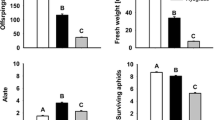Abstract
The two hop cultivars “Hallertauer Magnum” (HM) and “Spalter Select” (SE) are regarded by growers as extremely different in their susceptibility to the damson-hop aphid Phorodon humuli (Schrank). To investigate these anecdotal observations, spring migration and initial population development of P. humuli were monitored on the two cultivars in 1998 and 1999 in an experimental hop garden. Numbers of migrant aphids on SE were significantly lower, comprising 18.8 and 30.2% as compared to HM in 1998 and 1999, respectively. Population development of apterous aphids on these two cultivars differed significantly. At the end of the monitoring period numbers of aphids on SE were 7.5 and 14.2% as compared to HM in 1998 and 1999, respectively. In behavioral studies of P. humuli alates released on glasshouse plants, those on SE spent significantly more time in motile behavior patterns than aphids on HM. In the glasshouse, population development also differed significantly and the number of aphids developing on SE was 12.9% of that on HM after 28 days. It is concluded that SE exhibits a certain repellent effect on P. humuli and, compared to HM, is possibly nutritionally less suitable to the aphid.
Similar content being viewed by others
References
Barber, A., Campbell, C. A. M., Crane, H., Darby, P., and Lilley, R. (2003). Cost-benefits of reduced aphicide usage on dwarf hops susceptible and partially resistant to damson-hop aphid. Ann. Appl. Biol. 143: 35–44.
Campbell, C. A. M. (1977). Distribution of damson-hop aphid (Phorodon humuli) migrants on hops in relation to hop variety and wind shelter. Ann. Appl. Biol. 87: 315–325.
Campbell, C. A. M. (1983). Antibiosis in hop (Humulus lupulus) to the damson-hop aphid, Phorodon humuli. Entomol. Exp. Appl. 33: 57–62.
Campbell, C. A. M. (1991). Response of Phorodon humuli to yellow and to green hop foliar colours. Entomol. Exp. Appl. 60: 95–99.
Campbell, C. A. M. (2001). Integrated management of damson-hop aphid on dwarf hops. Proceedings of the Scientific Commission of the International Hop Growers’ Convention. Canterbury, Kent, England, 5–7 August 2001, pp. 61–65.
Campbell, C. A. M., Pettersson, J., Pickett, J. A., Wadhams, L. J., and Woodcock, C. M. (1993). Spring migration of damson-hop aphid, Phorodon humuli (Homoptera, Aphididae), and summer host plant-derived semiochemicals released on feeding. J. Chem. Ecol. 19: 1569–1576.
Darby, P., and Campbell, C. A. M. (1988). Resistance to Phorodon humuli in Hops. IOBC/WPRS Bull. 5: 56–63.
Darby, P., and Campbell, C. A. M. (1996). Aphid-resistant hops—The key to integrated pest management in hops. Brighton Crop Prot. Conf. Pests Dis. 1996: 893–898.
Dorschner, K. W., and Baird, C. R. (1988). Susceptibility of hop to Phorodon humuli. Entomol. Exp. Appl. 49: 245–250.
Dorschner, K. W., and Baird, C. R. (1989). Electronically Monitored Feeding Behavior of Phorodon humuli (Homoptera: Aphididae) on Resistant and Susceptible Hop Genotypes. J. Insect Behav. 2: 437–446.
Dorschner, K. W., and Kenny, S. T. (1992). Occurrence of hop aphid phagostimulants in the honeydew of aphids. Entomol. Exp. Appl. 65: 49–55.
Eppler, A. (1986). Untersuchungen zur Wirtswahl von Phorodon humuli Schrk. I. Besiedelte Pflanzenarten. Anz. Schädlingskde. 59: 1–8.
Eppler, A. (1989). Settling behaviour of Phorodon humuli in relation to virus spread. Proc. Intern. Workshop Hop Virus Dis. Rauischholzhausen 1988, pp. 113–120.
Hornung, U. (1975). Zum Einflußder Wirtspflanze auf ihren Parasiten am Beispiel Humulus lupulus L.—Phorodon humuli Schrank. Angew. Bot. 49: 45–53.
Hrdý, I., Kremheller, H. T., Kuldová, J., Lüders, W., and Ula, J. (1986). Insektizidresistenz der Hopfenblattlaus, Phorodon humuli, in böhmischen, bayerischen und baden-württembergischen Hopfenabaugebieten. Acta Entomol. Bohemoslov. 83: 1–9.
Kralj, D., Kač, M., Dolinar, M., Ž olnir, M., and Kralj, S. (1998). Marker-assisted hop (Humulus lupulus L.) breeding. Monatsschr. Brauwissensch. 1998: 111–119.
Lösel, P. M., Lindemann, M., Scherkenbeck, J., Maier, J., Engelhard, B., Campbell, C. A. M., Hardie, J., Pickett, J. A., Wadhams, L. J., Elbert, A., and Thielking, G. (1996). The Potential of Semiochemicals for Control of Phorodon humuli (Homoptera: Aphididae). Pestic. Sci. 48: 293–303.
Paul, T. A., Darby, P., Green, C. P., Hodgson, C. J., and Rossiter, J. T. (1996). Electrical penetration graphs of the damson-hop aphid, Phorodon humuli on resistant and susceptible hops (Humulus lupulus). Entomol. Exp. Appl. 80: 335–342.
Author information
Authors and Affiliations
Corresponding author
Rights and permissions
About this article
Cite this article
Weihrauch, F., Moreth, L. Behavior and Population Development of Phorodon humuli (Schrank) (Homoptera: Aphididae) on Two Hop Cultivars of Different Susceptibility. J Insect Behav 18, 693–705 (2005). https://doi.org/10.1007/s10905-005-7020-9
Revised:
Accepted:
Issue Date:
DOI: https://doi.org/10.1007/s10905-005-7020-9




